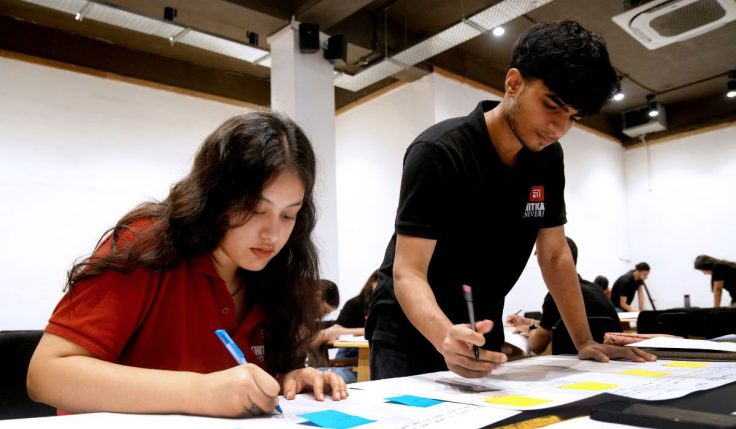Color is a potent tool that can elicit feelings, set moods, and even affect behavior. It is more than just a visual aspect. Understanding color psychology is crucial in interior design to create functional, aesthetically pleasing environments. Explore the realm of color psychology with me to see how various shades may change our homes and workplaces.
Explore the realm of color psychology
1. Color’s psychological effects on design
Colors evoke strong emotional reactions, with each hue eliciting distinct emotions and feelings. For example, cool colors such as blue, green, and purple create sensations of peace, relaxation, and tranquility. In contrast, warm colors like red, orange, and yellow often inspire energy, passion, and enjoyment.
To build rooms that speak to our customers and support their desired mood and ambiance, interior designers need to understand these emotional linkages.
2. Color theory’s significance in interior design
A key component of interior design is color theory, which explains how different hues interact to provide balance and harmony in a room. To create designs that complement the overall design concept while being aesthetically beautiful and unified, this understanding is necessary.
Color has strong cultural connotations and meaning, therefore when creating rooms for clients from different backgrounds, it must be taken into account. We may produce designs that are sympathetic to the cultural values and preferences of our clients by considering these variables.
3. The impact of color psychology on the perception of space
In interior design, color psychology can have a significant effect on how a user experiences space. Create focal points to guide the eye and use color strategically to enhance the perception of space in rooms.
Additionally, by enhancing particular activities and functions inside a location, color can contribute to the creation of distinct user experiences. Adding energetic colors to a home office boosts productivity and focus, while soothing colors in a bedroom promote rest.
4. Psychological aspects of color perception
Context and environment, along with individual experiences and preferences, all have an impact on how people see color. An individual’s reaction to a color can be influenced by their own experiences, and the context in which a color is presented can affect the color’s perceived meaning and emotional resonance.
Interior designers must be aware of these aspects and take them into account when choosing colors for spaces. By doing this, we can produce designs that genuinely speak to our customers and promote their mental health.
Three ways that color affects psychology
1. Effects that are peaceful and soothing
It is well-recognized that some colors, such as gentle blues, greens, and neutrals, provide these mental benefits. These colors are perfect for bedrooms and living spaces since they can produce a calm and soothing ambiance.
2. Effects that are stimulating and energizing
Bright colors like red, orange, and yellow can cause emotions of excitement and vitality. These colors are great for areas like playrooms or home offices since they encourage creativity, concentration, and production.
3. Perception of space
Colors affect how we see space as well. Darker colors make spaces feel smaller and cozier, while lighter colors make rooms seem wider and more open.
Conclusion
color psychology is a critical component of interior design, impacting both the user’s emotional experience and the space’s visual appeal. Designers may create rooms that are not only visually beautiful but also useful and conducive to their intended purpose by understanding the impact of color on emotions, productivity, and harmony. Thus, remember the impact of color the next time you’re designing a room makeover or office renovation!
At Chitkara University, the four-year B.Des in Interior Design curriculum covers a wide range of topics, including history, theory, materials, lighting, construction techniques, and technology. Internships with prestigious architecture and design businesses give students practical experience in the field. Students are guaranteed placement in prestigious design and architecture businesses upon graduation.
The curriculum attempts to improve students’ capacity to plan, organize, design, and detail a variety of interior spaces, including residences, businesses, public buildings, and cultural institutions. In addition, it aims to make students aware of how interior design affects the built environment and provides them with the technical, artistic, theoretical, and managerial abilities needed to complete projects successfully. To improve creative insight, the program promotes an interdisciplinary approach that involves working with illustrators, sculptors, fashion designers, and architects.
Also, read this blog post: Digital Tools in Interior Design: Navigating the Landscape
The program’s project-based approach, which enables students to investigate the creative and beautiful facets of interior architecture and design while learning about the practical and technical facets, is one of its best features. Study tours, mini-internships, and design competitions are examples of industry engagements that help students get exposure to the field and hands-on experience. The faculty is made up of accomplished researchers, architects, designers, and artists who serve as mentors to students for both professional and personal development.
To educate students for jobs in designing both aesthetically beautiful and practical spaces, the curriculum integrates theory and practice. Students learn how to make models, solve problems, and test ideas through a combination of practical experience in workshops and digital fabrication labs and design studio instruction. In order to help students integrate into the business and pursue jobs as exhibition designers, furniture designers, interior and spatial designers, and other professions, the program also provides internships and links with specialists in the field.






